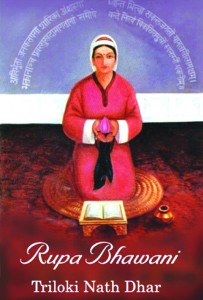Rupa Bhawani
This is a collection of articles archived for the excellence of their content. |
Philosphy of Rupa Bhawani
Dr. Raj Shree Dhar, Philosphy of Rupa Bhawani "Daily Excelsior" 20/9/2015
Devi Rupa Bhawani, like Lal Ded, is one of the great female mystic poets of Kashmir.
Rupa Bhawani was the second great mystic poet of 17th century. She had a great and deep experience of ups and downs of life. The worldly sufferings showed her the path of spiritual life. Her spiritual ‘Guru’ was her father Pandit Madhav Joo Dhar who initiated her into the mysteries and practices of yoga. She gave rich mystic poetry to Kashmiri language. In her poetry, we can find the influence of both Kashmir Shaivism and Islamic Sufism.
Yogeshwari Lalla was the first Saraswat Saint Poetess of Kashmir. Born in the first quarter of the 14th Century she was the harbinger of the unexpected overall politico religious change of Kashmir, and in accordance with the will of the Great KALA (Time) thousands of years old Hindu Kingship had to yield place to the Islamic dynastic rule. With this change she however preserved the ancient Cultural heritage of the Kashmiri by preaching in the common man’s tongue the high principles and teachings of Shaivism. Three centuries later another yogini took birth. Had it any purpose? In this universe nothing happens without a purpose underlying it. Religious fanaticism had to be tempered; the ideal of secularism-for the Kashmiris are basically one race of Saraswats, tolerance, co-operative understanding had to be spread far and wide. And for that Rupa Bhawani or Alakeshwari or Ropded appeared on the scene.
Her father Madho Dhar, a staunch devotee of Bhagwati Sharika, whose sacred hill he went round every morning bare footed …would be seen holding discourses and discussions with the Muslim saint Thag Baba just across the river opposite his residence at Nawakadal, Srinagar. Roopa was the Goddess Sharika incarnate, and thus she maintained the tradition that Yaiva Uma-Saiva Kashmira … She who is Uma is Kashmir.
T. N. Dhar the author of this Volume of sayings, life and doings of the great Rupa-Bhawani, had collected the verses of the Devi and translated them into English, Mr. Dhar has stated that there are 146 Vakyas. Shri Dhar has taken great pains in collecting all the relevant information concerning Yogni Rupa Bhawani Jee, and in translating her Vakyas, he has employed his intelligence, personal knowledge of a karmishta, and scholarship. Triloki Nath Dhar has rightly said that the Vakyas are what they are. And no one has the right or the authority to add to, alter or amend the Vakyas. They have their own metre, their own way of expression.
This book has made an in- depth study of the scriptures, philosophical literature and other connected works. The author himself has made the requisite spiritual journey to enable him to give detailed analytical meaning of the vakyas by the divine mother. Translating the vakyas of Rupa Bhawani has been a herculean task and only because it required intellectual acumen, spiritual depths, highest knowledge of philosophy propounded here but also required literary proficiency and a researcher’s insight to decipher and understand them. Triloki Nath Dhar has also drawn parallel to what Lord Krishna has said in the Bhagwat Geeta and has quoted from the English Literature to bring home the points made in various vakyas, substantiating the interpretation provided by him.
Each Vakya is explained first in a free verse followed by a supplementary comment. As per Mr. Dhar, “My object has been to pull out, into a clear stream, content and meaning of each verse out of the tangled web of aphoristic, terse, riddling and suggestive and at places mutilated expressions.”
This is a work by a devoted scholar requiring thought and understanding of a high order and this book is dedicated research and explication. His published works include Theory of Creativity, Tale of a Soviet Biologist, A Bunch of Short Romances, Origin of Saraswat Aryans, Concept of I, The Cascades, The Holy Virgin (an epic fragment), Inspiration in the North- East, The story of Kashmir Affairs and the sundry topics, The Battered Hindu.
(The author is life member, ALAKH SAHIBA TRUST, Talab-tillo Jammu)
